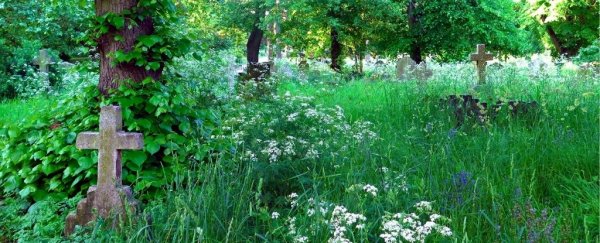Environmentalists are more aware than most people of their effect on the planet, but a small new study suggests some lifelong greenies are not necessarily up-to-date on the latest sustainable options for life after death.
Little research has been done on what environmentalists want to do with their bodily remains after they die, but interviews with 20 environmentalists between the ages of 60 and 88 living in Kansas, found many aren't considering a "green" burial, even when the option is close by.
Green burials have seen a resurgence in recent years. Generally, this type of burial seeks to improve on traditional burials and cremation by reducing greenhouse gases, protecting natural habitats, ditching the embalming process – which can leach harmful chemicals into the environment – and rethinking the material used for buried containers, which can be toxic or hard to break down.
"While connected in multiple ways with one another for various eco-concerns, the accessibility and re-emergence of green burials had not filtered through this cohort of environmentalists," the authors conclude.
In the study, the 20 participants were asked specific questions about whether they would like their body to be embalmed and buried, cremated, donated to science, or given a green burial.
While many participants in the study said they were still thinking about their choices and were open to new ideas, most preferred to be cremated.
The option for a green burial was known to only a few – despite the fact that Lawrence, Kansas, was the first city in the United States to offer a green burial option. Numerous residents interviewed didn't even know there were laws saying they can be buried on their own land.
"[I]t's not even on their radar," says sociologist Paul Stock at the University of Kansas.
"We were often the ones introducing these people that are so knowledgeable in so many areas of the environment and activism to green burial. We would ask them, 'Do you want your body to be buried in a green burial?' And many would say, 'I don't know what that is, can you tell me about it?'"
The idea of a green burial has slowly become more popular in recent years. A 2017 survey from the National Funeral Directors Association 7, found nearly 54 percent of Americans are considering a green burial, and 72 percent of cemeteries are reporting increased demand. But the findings of this new research suggests awareness is still lacking, even in cities and states that allow for unconventional burials.
One participant had heard of green burials but hadn't done enough research to understand them fully. His wife, who was also interviewed, didn't know about the option at all. In the end, they both agreed they would consider the idea and were shocked that such a choice was available in Lawrence (at the time, it was the only municipal-owned cemetery with a green burial option in the country).
"Here in Lawrence? Right here in the backyard? … [B]ut, they're still putting you in the ground, right?" they asked.
Of the small number who had heard of green burials, most were excited by the prospect of becoming one with nature.
"I am so deeply joyful at the idea that I will be turned into good earth and perhaps be useful to insects, worms and plants that will be using that Earth," one volunteer said.
Others were sad the decision would ultimately mean they could not be buried alongside their families, but they still wanted to make that sacrifice.
"I'm interested in being with the worms … I just think it'll be great, good company," said one woman who had chosen a green burial site in a different spot from her family.
Altogether, more than 50 percent of those interviewed chose cremation – mostly because it was easier for their relatives to organise, it conserved land, and they could be scattered in their favourite places.
"I intend to be cremated because it's not environmentally correct to occupy a space," replied one participant.
"It's a little – I don't know. What's the right word? Too American? Too arrogant, something, say, 'Yeah, I need [to be in] a f***ing box for the next 15,000 years'. "
While some environmentalists preferred cremation because they considered it a more natural process – "Ashes to ashes. Dust to dust," replied one participant. "It's a faster process of going back to the earth" – actual research comparing the environmental impacts of cremation versus other choices for burial are few and far between.
One of the few recent studies, published in 2017, found cremation was only a marginally greener option. In fact, estimates suggest the carbon footprint of cremation is roughly equivalent to a 500-mile car journey.
"There are really just one or two papers out there using common environmental measurements – whether it's a carbon footprint or some other kind of way – to even give us technical measurements to compare," says Stock.
"We essentially don't have too much information to guide us as scientists, much less for older adults as to what is the greenest way of taking care of one's remains."
Today, green burials are highly varied, which makes it hard to say how environmental they truly are. People can choose to avoid embalming only, or they might swap a concrete vault or a toxic burial container for a cotton shroud. Other services include growing a variety of plants on your grave or enclosing a body in a mushroom 'suit' that grows toxin-clearing fungi beside you.
The choices for human burial are slowly expanding, yet research and public awareness needs to catch up. As the authors note, you have to be empowered to go against the grain, and the first step is knowing your options.
The study was published in Mortality.
